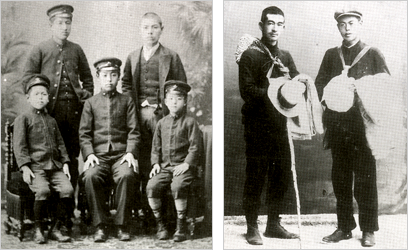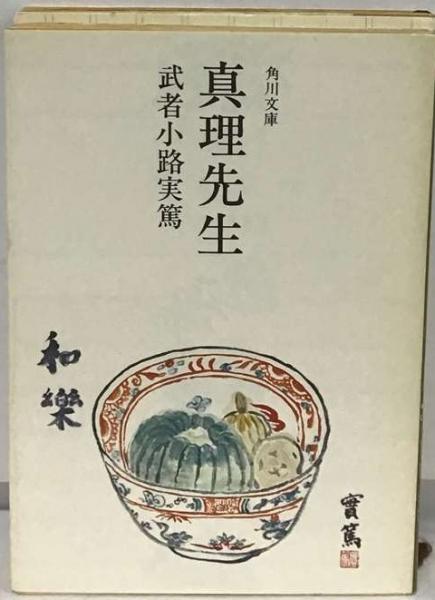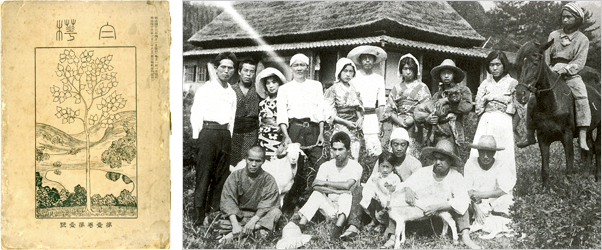
About Mushanokōji Saneatsu 武者小路 実篤
Partager
Mushanokōji Saneatsu 武者小路 実篤 (1885–1976)
Biography
Mushanokōji Saneatsu was born in 1885 into an aristocratic family in Tokyo. He studied at the Gakushūin (a school for the Japanese nobility), where he became close friends with Shiga Naoya and Shiga Shigetaka. In 1910, together with Shiga Naoya, Arishima Takeo, and others, he co-founded the literary journal Shirakaba (White Birch), becoming one of the central figures of the Shirakaba school. Beyond novels and plays, he was also deeply passionate about painting and calligraphy, leaving behind a large body of works that combined text and image.
During the late Meiji and early Taishō eras, Japanese society was undergoing rapid modernization, and traditional values clashed intensely with Western ideas. The literary world was divided among naturalism, anti-naturalism, and romanticism. The Shirakaba school valued humanism, individual dignity, beauty, and love, and stood in opposition to the hypocrisy and repression of the era.
Although the Meiji Restoration had abolished the samurai class, strong class distinctions between the aristocracy, former samurai, and commoners remained. Mushanokōji and Shiga Naoya, themselves from noble families, experienced firsthand the restrictions and hypocrisy of aristocratic society. Marriage, friendship, and employment were still influenced by social rank, making it difficult for people of different classes to freely come together.

In literature, naturalism became dominant toward the end of the Meiji period, emphasizing that “environment and heredity determine destiny,” often with a pessimistic and repressive tone. At the same time, strict censorship was enforced, and works criticizing the government or traditional morality could be banned. The Shirakaba group took the opposite stance: they celebrated human nature, emphasized personal dignity and creativity, and were strongly influenced by Western thinkers such as Leo Tolstoy, Dostoevsky, and Rodin. They stressed that every human being possesses innate worth and dignity, and that literature should address “how to live a more meaningful life” rather than merely depicting society’s darkness.
The Shirakaba school believed that people could overcome hardship, express themselves, and live with honesty and sincerity. They criticized the rigid class system and moral constraints of Japanese society, advocating instead for free expression and inner sincerity, rejecting false authority and formalized morality.
Representative Works of Mushanokōji Saneatsu

- Novel: Friendship (Yūjō, 1919) — explores the purity of human friendship.
- Play: Master of Truth (Shinri Sensei) — examines the conflict between ideals and reality.
- Painting and Calligraphy: Throughout his life, Mushanokōji produced many works combining painting and calligraphy. His typical subjects were flowers, accompanied by short, philosophical inscriptions.
Atarashiki Mura (The “New Village” Movement)

- Members engaged in collective labor (farming, handicrafts).
- They shared the fruits of their labor, rejecting excessive competition.
- They emphasized art and spiritual life: painting, music, reading, and intellectual exchange.
- Their guiding motto was “Beauty, Love, and Truth” (Bi to Ai to Shin).
Although Atarashiki Mura never developed into a large-scale utopia, it influenced many young people and became a symbolic experiment in the history of modern Japanese thought.
Postwar Years and Later Life
After World War II, Mushanokōji turned increasingly toward painting and calligraphy, he traveled to Europe and America in 1936, visiting art galleries around the world and writing numerous critical articles. He began painting around the age of 40 and created many works in his unique and beloved style. He often painted simple flowers—chrysanthemums, plums, sunflowers, cosmos—paired with short, optimistic sayings about life.
He continued creating works well into his old age, and passed away in 1976 at the age of 90, leaving behind a vast legacy of writings and art.




